Apr 13, 2025
Apr 13, 2025
Continued from “Isfahan is Half of The World”
The Irresistible Iran – 2
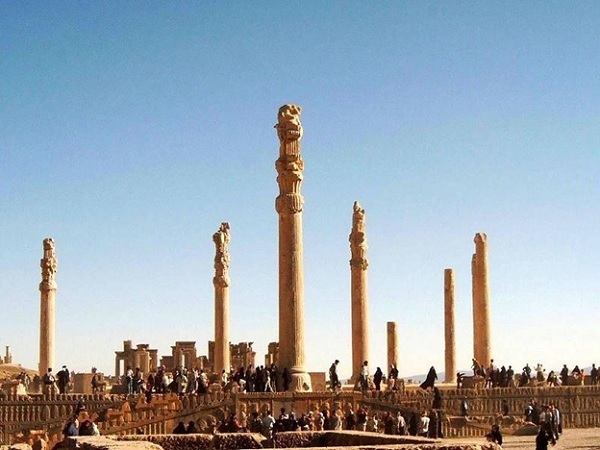
If Isfahan is the glorious legacy of Safavid Empire, Shiraz stands testimony to Zand dynasty (1750-94) and retains the charming examples of their architecture styles. Shiraz is the cultural capital of Iran and its real history dates back to a much earlier period. It is also the base camp for visiting Persepolis, the site of Achaemenid dynasty (550-330 BC) that ruled over the first and largest 'world empire' in history. Shiraz is mentioned in Elamite inscriptions from around 2000 BC and it was an important regional center under the Sassanians. By 1044 Shiraz was said to rival Baghdad in importance and grew further under the Atabaks of Fars in the 12th century, when it became an important artistic center.
Shiraz was spared destruction by the rampaging Mongols and Tamerlane in 13th century because the city’s rulers wisely decided that paying tribute was preferable to mass slaughter. Having avoided calamity, Shiraz enjoyed the Mongol and Timurid periods, which became eras of development. The encouragement of enlightened rulers, and the presence of Hafez, Sa’di and many other brilliant artists and scholars, helped make it one of the greatest cities in the Islamic world throughout the 13th and 14th centuries.
This is a city of poets and home to the graves of Hafez and Sa’di, themselves major pilgrimage sites for Iranians. Shiraz is also home to splendid gardens and exquisite mosques. It was once very famous for its wine too (pity that this legacy wasn’t carried forward) when European traders settled here to export its famous wine.
CITADEL OF KARIM KHAN
Dominating the city center, the burly citadel of Karim Khan (better known as Arg-e Karim Khan) was built in the early Zand period and formed part of the royal court that Karim Khan, founder of the Zand Dynasty, had hoped would develop to rival Isfahan. The exterior is fairly mundane. It has a land area of 4,000 square meters and is in the center of a 12,800 square meter compound. The citadel of Karim Khan consists of four high walls connected by four 14 meters round brick towers at a 90-degree angles. The southeastern tower has a noticeable lean, having subsided onto the underground sewerage system that served as the Arg’s bathhouse.
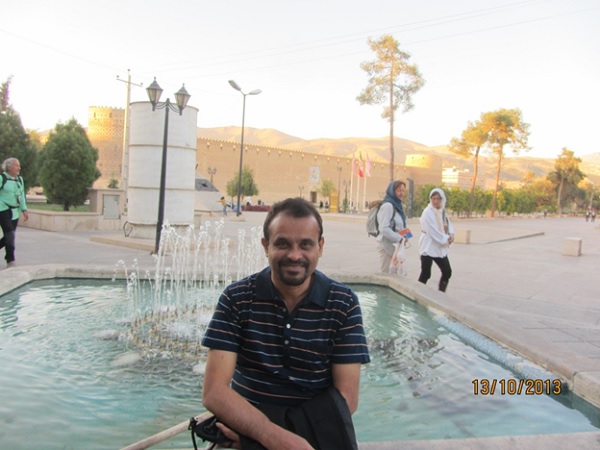
View of the Citadel from the nearby fountain
This citadel is the biggest and the most important building of the Zand Dynasty. Its shape resembles a medieval fortress. The design of the citadel combines military and residential architecture, for it was the home of Karim Khan and the military center of the dynasty.
Inside the Arg is a large, open courtyard filled with citrus trees and a pool. More interesting are the exhibition of photos taken in Shiraz in the late 19th and early 20th centuries, starting inside the north wall, and the museum of the Zand period, with wax figures in traditional dress. After the fall of Zand Dynasty and during the Qajar period, the citadel was used as a the big city prison and was put at the disposal of the police department. During all this time, all paintings were unfortunately covered with plaster and all rooms and halls were turned into small prison cells by constructing walls.
Eram Garden
Eram garden, one of the most beautiful gardens in country is located in the northwest of the city. Famous for its tall cypress trees and the meticulously landscaped grounds, the delightful Bagh-e Eram (Garden of Paradise) will impress every nature lover with its endless pathways and quiet surrounds. The gardens are centered on a pretty pool beside a Qajar-era palace, the Kakh-e Eram (Eram Palace), which is not open to the public. The gardens are managed by Shiraz University located adjacently. This place was a favorite haven of the Shah, and it’s only since the revolution that its glories have been fully accessible
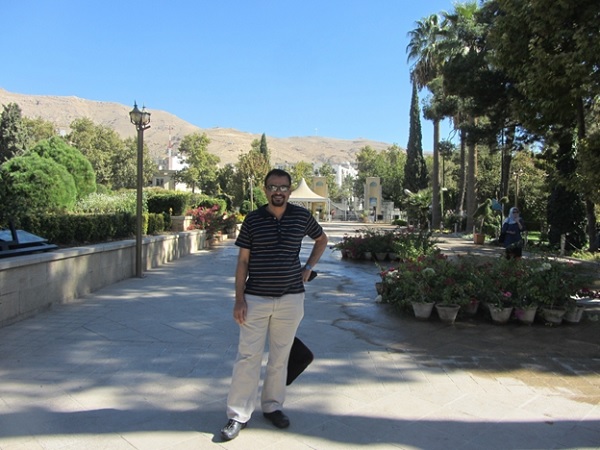
At the entrance of Eram Garden
Bagh-E Nazar & Pars Museum
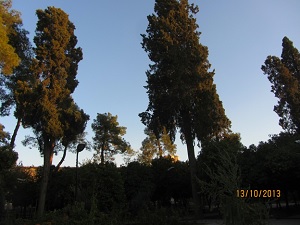 Bagh-e Nazar and the octagonal Pars Museum at its center are other notable Zand-era additions. It’s possible to walk around the garden and view the delightfully decorated pavilion where Karim Khan received foreign dignitaries. The interior is stunning, with the stalactite ceiling a particular highlight. Exhibits include Karim Khan Zand’s sword and indeed, his grave. No photography is allowed here and hence I couldn’t get any snaps of the interior.
Bagh-e Nazar and the octagonal Pars Museum at its center are other notable Zand-era additions. It’s possible to walk around the garden and view the delightfully decorated pavilion where Karim Khan received foreign dignitaries. The interior is stunning, with the stalactite ceiling a particular highlight. Exhibits include Karim Khan Zand’s sword and indeed, his grave. No photography is allowed here and hence I couldn’t get any snaps of the interior.
Masjed-E Vakil
The beautiful Masjed-e was begun by Karim Khan and is the only major mosque surviving from the late Zand period. Beside the entrance to the bazaar, it has two vast iwans to the north and south, a magnificent inner courtyard surrounded by beautifully tiled alcoves and porches, and a pleasingly proportioned vaulted prayer hall supported by 48 carved columns.
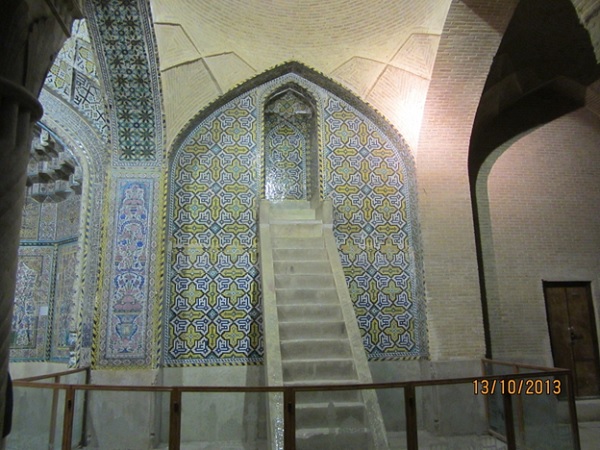
14-step marble minbar in Masjed-E Vakil
Inside the prayer hall are an impressive mihrab and 14-step marble minbar, carved from a monolith carried all the way from Azerbaijan. Much of the tiling, with its predominantly floral motifs and arabesques, was added in the early Qajar era.
Hammam-E Vakil
Hammam-E Vakil which was constructed by Karim Khan is one of the finest bath houses; it’s worth popping in for a look at the classic baths built in Iran. Vakil bath is the other building located next to the mosque and represents the old public bathrooms from 200 years ago. Inside, you can see the beautiful decorations on pastured walls and figurines illustrating services offered to customers and massage scenes from the old bath houses.
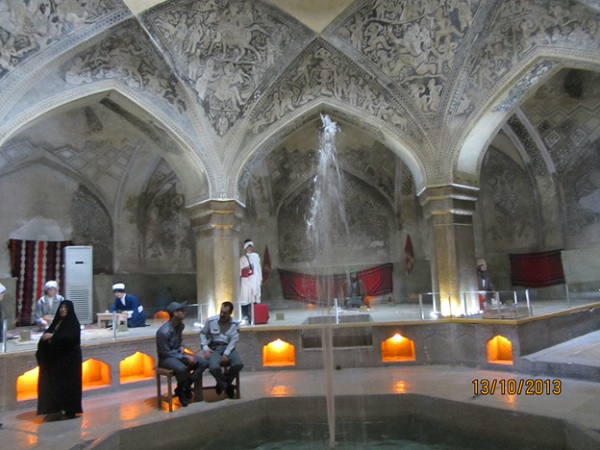
Bath house- Hammam-E Vakil built by Karim Khan
Bazar-E Vakil
Shiraz’s ancient trading district is comprised of several bazaars dating from different periods. The finest and most famous is the Bazar-e Vakil, a cruciform structure commissioned by Karim Khan as part of his plan to make Shiraz into a great trading center. The wide vaulted brick avenues are masterpieces of Zand architecture, with the design ensuring the interior remains cool in summer and warm in winter.
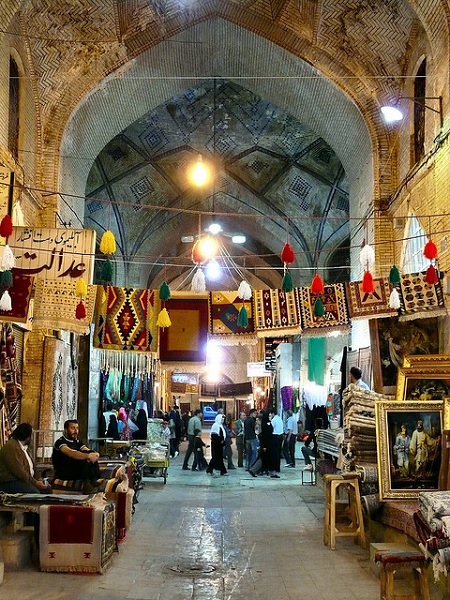
A shopping scene of Bazar-e Vakil
This Bazaar is the glory of Shiraz and the whole Bazaar is a spacious and lofty street and divided, as my guide Nazereh Jamali assured me, into 1500 shops. Whether it is exaggerated or not, I had no time or patience to ascertain! But I did quite a lot of walking and it has myriad arteries creating an endless feeling and every corner of the bazaar was as busy and inviting as the entrance. There is a fine traditional restaurant at the end of one of the alleys in this bazaar where we had the dinner on the first day. It is indeed a beautiful place fully decorated with mirrors and Persian artifacts.
Aramgah-E Hafez (The Tomb of Hafiz)
Hafez (1324-1391), the greatest master of Persian lyric poetry and the literary giant of the 14th century in the west and central Asia, was born in Shiraz, lived all his life here, sang its praises in unsurpassed verse and wrote lyrical poems about love and the beloved, which are understood be imbued with deep Sufi mystical meaning. Hafiz was contemporary of the English poet Chaucer and was born about hundred years after another great Persian poet Rumi. Hafiz became known in the west largely through the efforts of Goethe, who enthusiasm rubbed off on Ralph Waldo Emerson, who translated Hafiz in 19th century. Many great writers like Nietzsche, Pushkin, Turgenev, Federico Garcia Lorca and even Sherlock Holmes were admirers of Hafiz.
His epithet ‘Hafez’ alludes to his memorizing of Koran by heart. Iranians have a saying that every home must have two things: first the Quran, then Hafez. And many would reverse that order. Hafez the poet is an Iranian folk-hero – loved, revered and as popular as many a modern pop star.
Though Karim Khan had earlier built a monument for him, as I understand, it was torn down to build this new monument in 1939 as per design of French architects.
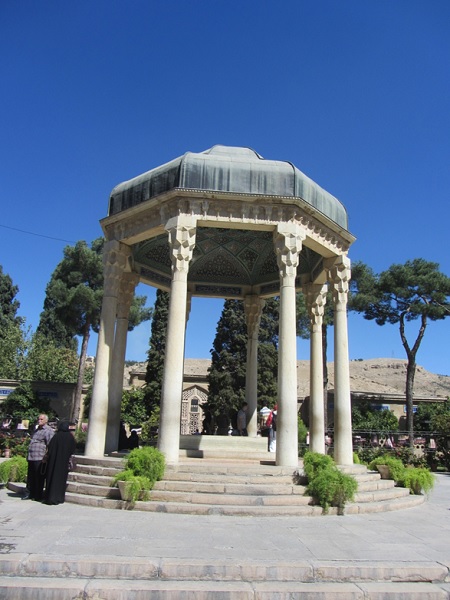
The tomb of Hafiz
Oriented toward qibla (southwest), the present complex is composed of two courts separated by a colonnaded hall of twenty columns standing at right angles to the entrance axis of the complex. The south garden consists of a central path with a flower bed in the middle and is lined with cypress trees. Behind the cypresses on either side of the south garden are groves of orange trees, each with a rectangular pool. At the center of the north court is the tomb of the poet, crowned by an open pavilion.
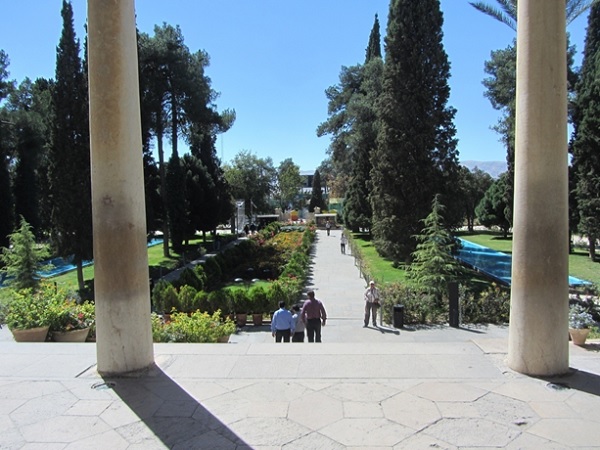
The garden at the entrance of Tomb of Hafiz
The pavilion stands on a circular plinth with five steps; it is composed of eight stone columns supporting an octagonal frieze topped by a metal roof whose form was inspired by a dervish’s hat. Tile inscriptions of Hafez’s poems run along the internal surface of the octagonal frieze. The interior of the dome is decorated with “arch-net” and intricate inlay work. Hafez’s grave is marked by the original marble tombstone from the Zand period, engraved with his own poems in nastaliq script and dated to 1773. Perhaps one line of Hafiz that is worth inscribing on every flag, temple, church, and mosque and even on every ruler’s brain is:
“Dear ones, Let us anoint this earth with dance!”
There is a good restaurant and music stall at this venue where we refreshed ourselves with authentic pomegranate Falooda and bought some music CDs of famous traditional Persian singers Shajarian and Shahram Nazeri.
Tomb of Sa’di
Commonly known as Saadi Mausoleum, this Orchard embraces Saadi (1209-1291), the other great Persian poet from Shiraz. Saadi’s extensive travels (He fled Mongol invasions, going to Baghdad and then Syria) gave him a sophistication that is echoed in his admirable poetry and rhythmic prose. His books are read and enjoyed by lovers of Persian literature across the world. The tomb of Sa’di is set in similar grounds near to Hafiz garden. The columned porch was built in the 50s on the remains of the former tombs. The combination of pink columns in contrast with the inside blue tiles is so picturesque. A number of his famous poems are written all over the blue tiles.
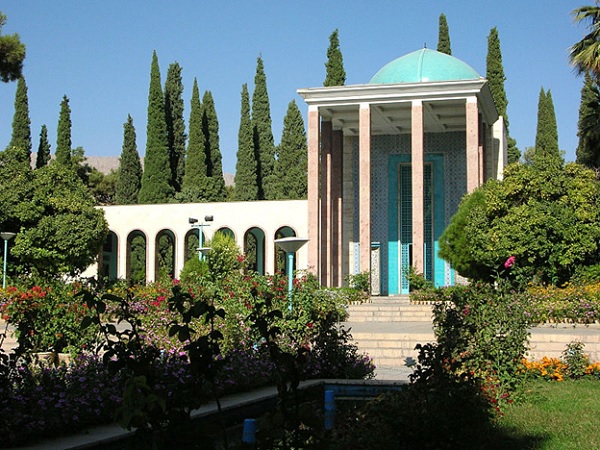
Exterior view of Tomb of Sa’di
Sa’di was a poet who preached universal brotherhood. One particular poem written eight centuries ago became a motto and decorates the gate of the United Nations building entrance. Titled Bani Adam, the Children of Adam, the poem is an aphorism calling for the breaking of all barriers and was quoted by president Obama in a meeting with Iranian leaders in 2009. I wish to quote it below:
“All Adam’s sons are limbs of one another,
Each of the self-same substance as his brother
So while one member suffers aches and grief,
The other members cannot win relief.
If you have no sympathy for human pain,
The name of human you cannot retain.”
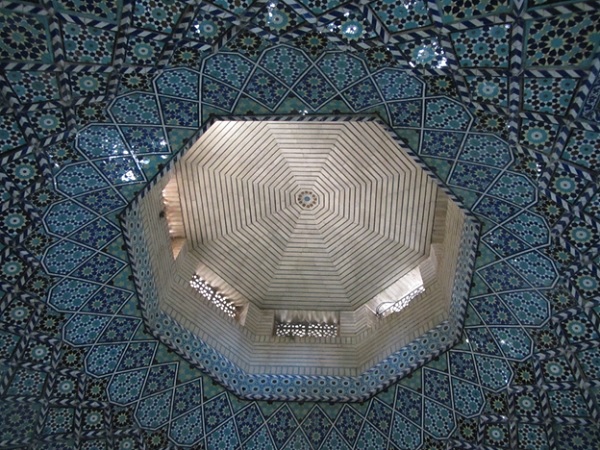
Roof above the magical well where water gets collected from nearby Mountain
There is a handicraft emporium located at this venue which is also worth visiting.
Nasir Al-Molk Mosque
One of the most beautiful mosques in Shiraz mixing the European symbols with Qajari architecture. It was built by Nasir Al Din Shah (1848-96) and has a rectangular court by single story of arcades and a columnar prayer-hall on the west. A shallow iwan in the south is flanked by two blind niches surrounded by kiosks on the roof and leads into a high chamber containing the Mihrab. The over-glazed painted tile work displays luxuriant bouquets of roses in pink, blue, yellow, violet and green on white background. It’s beautiful tile and brilliant stained glasses draw many visitors and photographers.
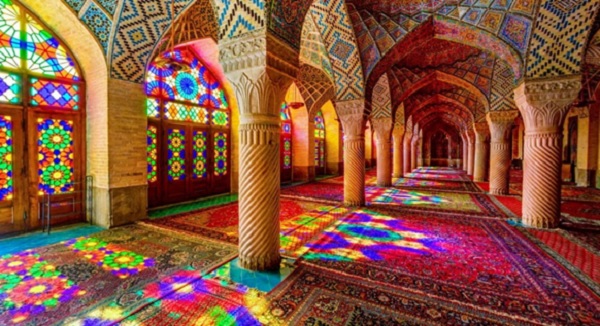
Beautiful arches and stained glass window in Nasir Al-Molk Mosque
Shah-E Cheragh Mausoleum (The Big Shrine)
This holy shrine is the burial place of Seyyed Mir Ahmad, the brother of Imam Reza (the eight Shiite Imam). It is very much respected among the locals and other Iranian pilgrims and it is the third important shrine in the country. It attracts many visitors because of the tile work, great silver doors and mirror works inside the mausoleum.
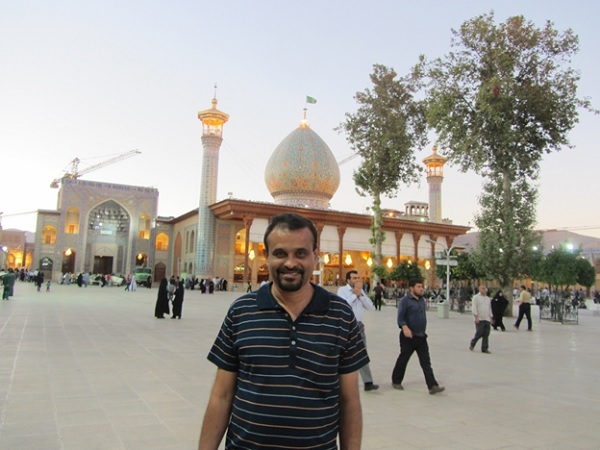
Shah-E Cheragh - One of the holiest mosques of Shiite Muslims
Shah-E Cheragh is Persian for “King of the Light”. The site was given this name due to the nature of the discovery of the site by Ayatullah Dastghaib (the great grandfather of the contemporary Ayatullah Dastghaib). He used to see light from a distance and decided to investigate the source. He found that the light was being emitted by a grave within a graveyard. The grave that emitted the light was excavated, and a body wearing armor was discovered. The body was wearing a ring saying, “The Pride belongs to God, Ahmad son of Musa”. Thus it became known that this was the burial site of the sons of Musa al-Kadhim.
The Peerless Persepolis
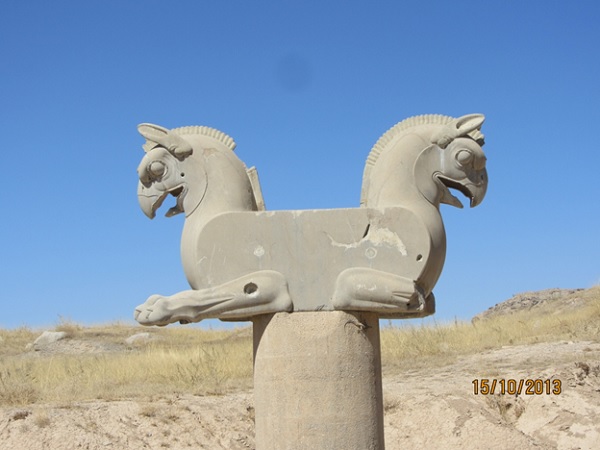
Two-headed griffin statue in Persepolis
Persepolis was the ceremonial capital of the Achaemenid Empire (ca. 550–330 BC). Persepolis is situated 70 km northeast of Shiraz and so I took up this journey to this historic site on my way to Isfahan. The earliest remains of Persepolis date from around 515 BCE. UNESCO declared the citadel of Persepolis a World Heritage Site in 1979. I had the honor of Mr. Gholam Ali, the official guide who escorted former Indian prime minister A B Vajapyee during his visit to Persepolis, accompanying me during this tour.
Archaeological evidence shows that the earliest remains of Persepolis date from around 515 BC. André Godard, the French archaeologist who excavated Persepolis in the early 1930s, believed that it was Cyrus the Great who chose the site of Persepolis and Pasargad as his capital, but that it was Darius I (Daryush) who built the terrace and the great palaces.
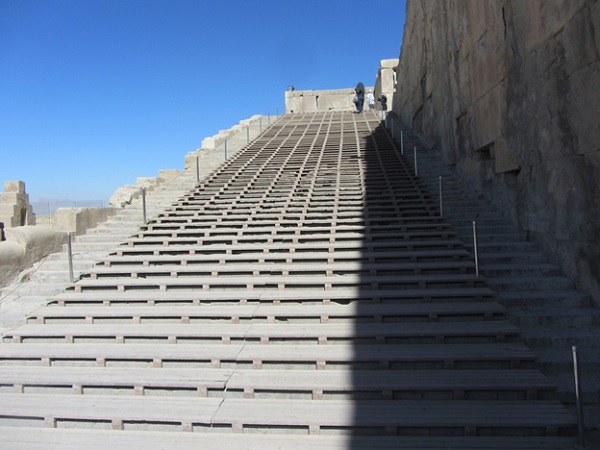
The stairway to terrace
Darius built the greatest palace at Persepolis in the western side. This palace was called the Apadana. The King of Kings used it for official audiences. The work began in 515 BC. His son Xerxes I completed it 30 years later. The palace had a grand hall in the shape of a square, each side with seventy-two columns. The tops of the columns were made from animal sculptures such as two headed bulls, lions and eagles. The columns were joined to each other with the help of oak and cedar beams, which were brought from Lebanon.
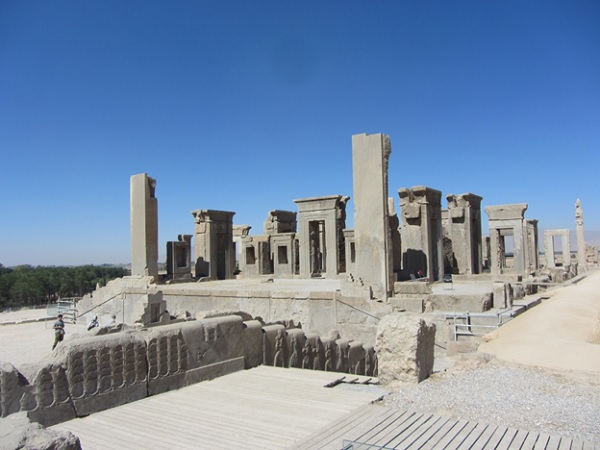
Tachara Palace of Darius
Magnificent Persepolis embodies the greatest successes of the ancient Achaemenid Empire and its final demise. The monumental staircases, exquisite reliefs and imposing gateways leave you in no doubt how grand this city was and how totally dominant the empire that built it. Equally, the broken and fallen columns attest that the end of empire was emphatic. Persepolis is a result of the vast body of skill and knowledge gathered from throughout the Achaemenids’ empire. It is Persian in ideology and design, but truly international in its superb architecture and artistic execution.
Persepolis was created to serve as the ceremonial and religious hub of an empire whose primary god was Ahura Mazda, also the subject of Zoroastrian worship. The Median capital at Shush became the administrative center, but Persepolis was the imperial showcase, extravagantly decorated to intimidate visitors and impress with its beauty. The Apadana Staircase, which depicts 23 subject nations paying tribute to the Achaemenid king, is arguably the artistic apex of the site. Darius eventually expanded the empire to India and pushed as far north as the Danube River in Europe.
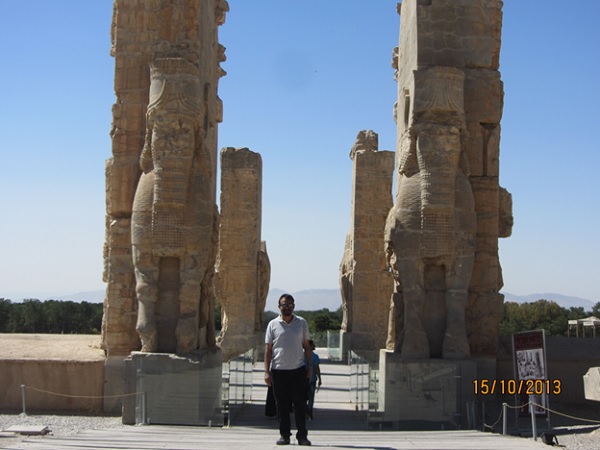
The all Nations gate: Bulls with Human heads (Chopped off during advent of Islam)
The multicultural complex in Persepolis stands alone as the greatest surviving masterpiece of the ancient Near Eastern civilizations. Respected scholar Arthur Upham Pope ably summed up the philosophy behind Persepolis in Introducing Persian Architecture:
“Humane sentiments found expression in the nobility and sheer beauty of the building: more rational and gracious than the work of the Assyrians or Hittites, more lucid and humane than that of the Egyptians. The beauty of Persepolis is not the accidental counterpart of mere size and costly display; it is the result of beauty being specifically recognized as sovereign value.”
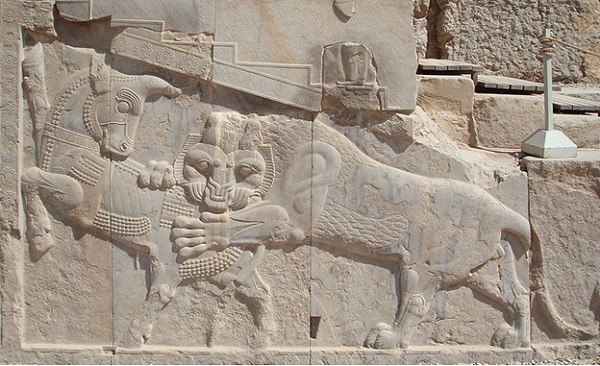
Bas-relief in Persepolis - a symbol Zoroastrian Nowruz -
in day of a spring equinox power of eternally fighting bull (personifying the Earth),
and a lion (personifying the Sun), are equal.
In autumn and summer reliefs, we see one conquering the other.
The end of the First Persian Empire finally came at the hands of Alexander the Great, king of Macedonia. Having defeated the Greeks and Egyptians, Alexander saw off Persian armies at Issus in Turkey (333 BC) and Guagamela in present-day Iraq (331 BC). By the time he arrived in Persia proper the end of the Achaemenid Empire was almost inevitable, and it wasn’t long before the last remaining armies of Darius III were swept aside. Darius himself fled east to Bactria, only to be murdered by his cousin. In the wake of his victory, Alexander spent several months at Persepolis, before the finest symbol of Achaeenid power was burned to the ground. Even today experts argue whether this was the accidental result of a drunken party or deliberate retaliation for the destruction of Athens by Xerxes.
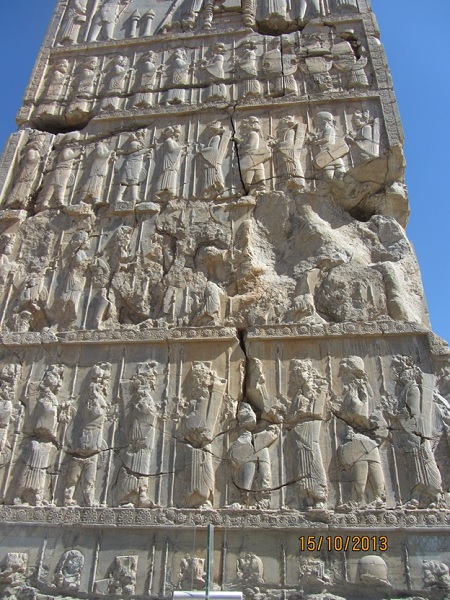
Bas-reliefs in Persepolis
It is well known that there were strong rivalry between Persians and Macedonians. Alexander described Persians to the Macedonians as the most hateful of the cities of Asia, and gave it over to his soldiers to plunder, all but the palaces. Persepolis was the richest city under the sun and the private houses had been furnished with every sort of wealth over the years. The Macedonians raced into it, slaughtering all the men whom they met and plundering the residences; many of the houses belonged to the common people and were abundantly supplied with furniture and wearing apparel of every kind.
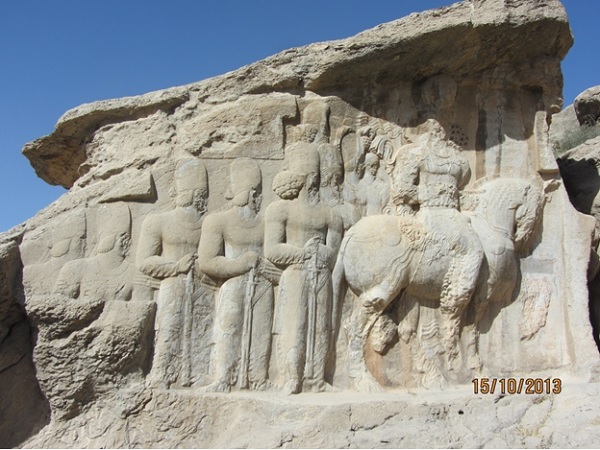
A rock relief from Naqsh-e Rajab site; about 12 KM from Persepolis dating back to early Sassanid era (241-272 AD). It is known as ‘Shapur’s Parade’ celebrates the king Shapur’s military victory in 244 over the Roman emperor Valerian and Philip the Arab.
The following story of destruction the great palace of Persepolis is from Wikipedia. What an irony that the conflagration of the palace was led by a woman named Thais!
“While they were feasting and the drinking was far advanced, as they began to be drunken a madness took possession of the minds of the intoxicated guests. At this point one of the women present, Thais by name and Attic by origin, said that for Alexander it would be the finest of all his feats in Asia if he joined them in a triumphal procession, set fire to the palaces, and permitted women's hands in a minute to extinguish the famed accomplishments of the Persians. This was said to men who were still young and giddy with wine, and so, as would be expected, someone shouted out to form up and to light torches, and urged all to take vengeance for the destruction of the Greek temples. Others took up the cry and said that this was a deed worthy of Alexander alone. When the king had caught fire at their words, all leaped up from their couches and passed the word along to form a victory procession in honour of Dionysius. Promptly many torches were gathered. Female musicians were present at the banquet, so the king led them all out for the drunken revelry to the sound of voices and flutes and pipes, Thais the courtesan leading the whole performance. She was the first, after the king, to hurl her blazing torch into the palace. As the others all did the same, immediately the entire palace area was consumed, so great was the conflagration. It was most remarkable that the impious act of Xerxes, king of the Persians, against the acropolis at Athens should have been repaid in kind after many years by one woman, a citizen of the land which had suffered it, and in sport."
Legacy of Cyrus The Great
The unearthing in today’s Iraq (in 1879) of a clay cylinder-shaped decree from Cyrus the Great, founder of the Achaemenid dynasty of Persia, stands in the same tradition of game-changing discoveries from antiquity as Hammurabi’s famous law code or the intact tomb of the boy-king Tutankhamun. For the Cyrus Cylinder contains cuneiform inscription recording, among other things a microcosm of the whole history of its period. Inscribed with an account of the conquest of Babylon in 539 BCE by the Persian King, it records an event which launched one of the greatest imperial adventures in history. It describes Cyrus’ capture and deposition of Nabonidus, last native Babylonian ruler (represented by the Cylinder text as an oppressor of his own people) and proclaims the Persian as a liberator. His annexation of Babylon was to become the platform upon which the Achaemenid military machine built its later vast imperium. But the Cylinder is more than an ancient exercise in propaganda. It has also been called the world's first declaration of human rights, setting out the decree by which Cyrus freed the Jews from captivity in Babylon.
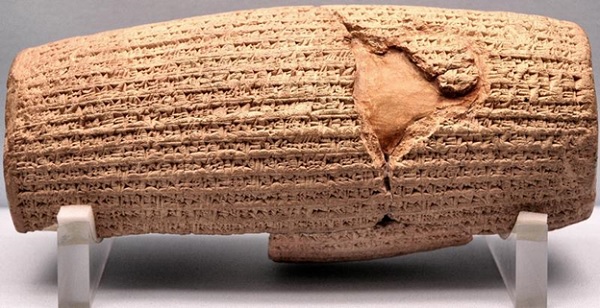
Cyrus Cylinder telling the history of Achaemenid dynasty
Many passages on the cylinder have been widely interpreted as a reflection of Cyrus’s respect for human rights, and many consider it the world’s first charter of human rights. A replica of it remains on permanent display at UN headquarters in New York.
Adieu Shiraz
It is with a sense of deep satisfaction that I left Shiraz, the city of poets, gardens, wine, nightingales and flowers. When I look back, I realize the pivotal role this city of knowledge has played in Persian history in terms of its vast contributions in the historical, intellectual, literary, scientific and cultural realms. In his 1893 book A Year Amongst the Persians, Edward Browne described Shirazis as
‘…amongst all the Persians, the most subtle, the most ingenious, the most vivacious’. And even in Iran, where regional one-upmanship is common, everyone seems to like Shirazis. One can hear here whispered echoes of ancient sophistication that reward those who linger longer than it takes to visit nearby Persepolis. It is certainly the cradle of Persian civilization.
(Next is the concluding part on Tehran )
03-Nov-2013
More by : P. G. R. Nair

|
I loved reading your work & enjoying the photos. Like yourself, all I knew of Iran was what I saw in the Western media.. I am from America and I traveled to Iran this past April with my friend whose family is from there. I fell in love with the county! It was so beautiful, every where we went. The people were like you said the nicest, most accommodating and warm people I have ever met in my travels. Looking through your photos and reading this took me back.. I can not wait to travel to Iran again. Thank you for putting this together. You did a wonderful job! |

|
I feel ashamed that I stayed close to this land for a long 35 years and never bothered to pay even a lighting visit. Iran seemed always out of bound due to the grim political scenario of the region. You are doing a wonderful job PGR-ji. The Iranians should take note and reward you. Please send a copy to their Tourism Department, if they have one that really wants to promote the land. |

|
Dear PGR, A great write up again.I feel the urge of visiting this place and I feel one week will be insufficient.. Awaits the release of Part -3 |